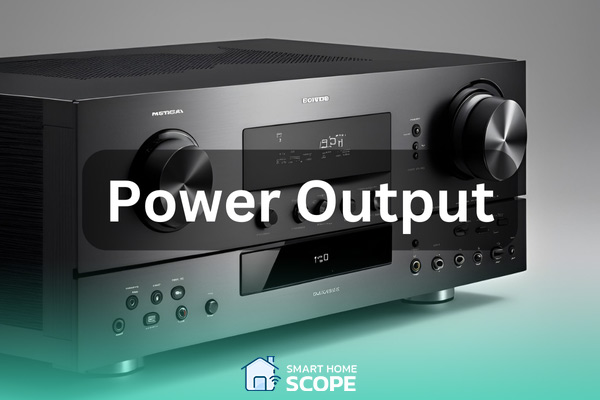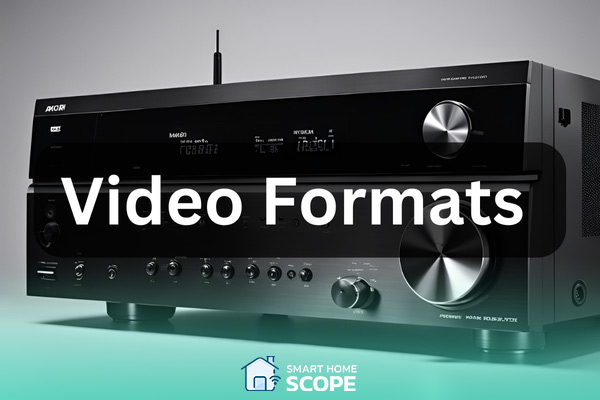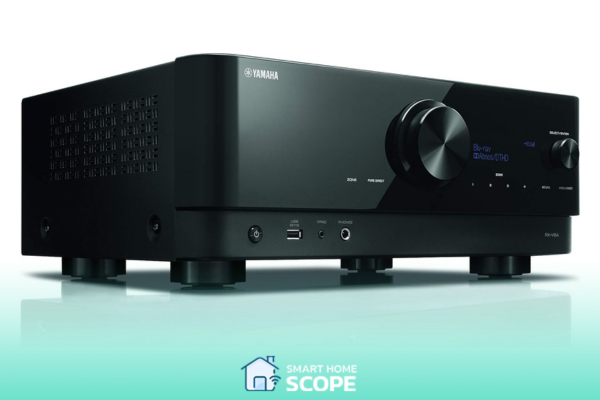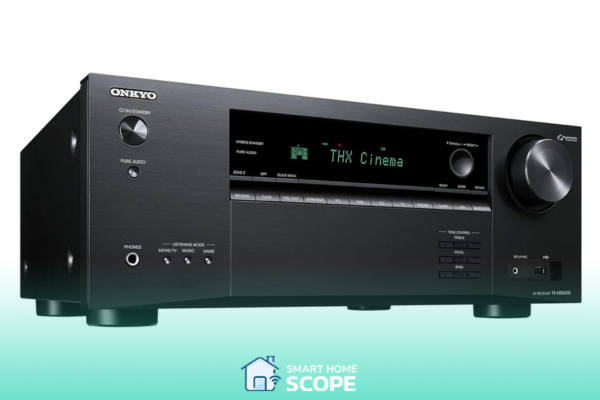In 2024, the best AV receiver stands out as a crucial component of any high-quality entertainment setup. I, Erfan Askari, have gained experience working with AV receivers, and I know how features like power output, audio/video capabilities, voice assistant support, room calibration technology, and more can enhance the overall performance of a home theater. Let’s explore the best AV receivers you can buy in 2024 to bring that cinema experience home!
What are the Best AV Receivers in 2024? (Quick Answer!)
Here’s my list of the best AV receivers for 2024. We’ll explore each device in detail:
- Denon AVR-X3700: Best overall
- Yamaha RX-V6A: Best for Yamaha lovers
- Sony STR-DN1080: Top choice for gamers
- Marantz SR-8016: Best for high-end home theaters
- Anthem MRX 1140: Best high-end AV receiver
- Onkyo TX-NR6100: Second-best overall home theater receiver
Here’s a table to help you compare these models at a glance:
| Feature | Denon AVR-X3700H | Yamaha RX-V6A | Sony STR-DN1080 | Marantz SR8015 | Anthem MRX 1140 | Onkyo TX-NR6100 | Winner |
|---|---|---|---|---|---|---|---|
| Channels | 9.2 | 7.2 | 7.2 | 11.2 | 11.2 | 7.2 | Marantz Anthem |
| Power Output | 105W per channel | 100W per channel | 165W per channel | 140W per channel | 140W per channel | 210W per channel | Onkyo |
| Video Support | 8K/60Hz, 4K/120Hz, HDR10, HDR10+, Dolby Vision | 4K/60Hz, HDR10, HDR10+, Dolby Vision | 4K/60Hz, HDR10, Dolby Vision | 8K/60Hz, 4K/120Hz, HDR10, HDR10+, Dolby Vision | 8K/60Hz, 4K/120Hz, HDR10, HDR10+, Dolby Vision | 8K/60Hz, 4K/120Hz, HDR10, HDR10+, Dolby Vision | Denon Marantz Anthem Onkyo |
| Audio Formats | Dolby Atmos, DTS, Auro-3D | Dolby Atmos, DTS | Dolby Atmos, DTS | Dolby Atmos, DTS, Auro-3D | Dolby Atmos, DTS | Dolby Atmos, DTS | Denon Marantz |
| Voice Control | Alexa, Google Assistant, Siri | Alexa, Google Assistant, Siri | None | Alexa, Google Assistant, Siri, Josh.ai | None | Alexa, Google Assistant, Siri | Denon Yamaha Marantz Onkyo |
| Room Calibration | Audyssey MultEQ XT32 | YPAO | DCAC EX | Audyssey MultEQ XT32 | Anthem Room Correction (ARC) Genesis | AccuEQ Room Acoustic Calibration | Anthem |
| Streaming Services | Spotify, Pandora, Tidal, Deezer, TuneIn, Soundcloud, AirPlay 2 | Spotify, Pandora, Tidal, Deezer, AirPlay 2, MusicCast | Spotify, Tidal, Chromecast, Bluetooth | Spotify, Amazon Music HD, Tidal, TuneIn, Deezer, Pandora, AirPlay 2, Bluetooth | Spotify, Tidal, AirPlay 2, Chromecast, Bluetooth | Spotify, Tidal, Amazon Music, AirPlay 2, Bluetooth | Denon Marantz |
| Price (New Unit) | $1199 – $1497 | $700 – $800 | Currently Unavailable | Around $1999 | Around $4999 | $480 – $800 | Onkyo |
We’ll go through each of these models one by one. If you’re looking for a more affordable AV receiver from popular brands like Denon or Onkyo, check out our Denon vs Onkyo guide!
Important features to consider in a home theater receiver

Connectivity Options (Vital when deciding on the best AV receiver)
Choose a receiver with many connectivity options, from multiple HDMI inputs for various devices to Wi-Fi and Bluetooth for wireless connectivity. Protocols like Apple’s AirPlay can enhance your experience if you’re in the Apple ecosystem. USB ports are also essential for playing media directly.
I find wireless streaming very useful in modern home theater devices. Here’s my view on this feature:
In modern home cinema systems, wireless streaming is crucial, enhancing user engagement through seamless connectivity. Innovations like Chromecast and AirPlay allow for easy content transmission from various devices, turning AV receivers into versatile entertainment hubs that integrate with home networks and offer extensive streaming options.
Other useful features I’ve found over the years are digital and analog audio inputs, which add versatility.

Audio Format Support
In 2024, the best AV receivers must support Dolby Atmos, DTS, and 3D rendering audio formats. These technologies are crucial for creating a three-dimensional audio effect, which is important for both movie and music lovers.
Ensure the receiver you choose supports THD (Total Harmonic Distortion), a feature that enhances sound fidelity. A lower THD percentage means clearer sound.

Power Output
Having used different receivers with many speakers in various room sizes, I’ve learned that more power doesn’t always mean better results. Room size is crucial when deciding on power output: larger rooms need higher power, while smaller rooms need lower power. Also, make sure the device’s power output aligns with your speakers’ capabilities; otherwise, you might experience distortion.

Video Capabilities
Opt for a receiver that supports the latest video formats such as 4K, 8K, and advanced gaming modes (if you’re into gaming), along with HDR formats like HDR10, HDR10+ and Dolby Vision. This makes your setup future-proof and reduces the need for upgrades in a few years.
There’s a big difference in how HDR10 and HDR10+ enhance the display, when putting them head-to-head, you see that HDR10+ does a better job managing brightness and color. Therefore an AV receiver that support HDR10+ is much better than one that doesn’t.
User Interface and Control
A user-friendly interface is essential. Many modern receivers support smartphone app control, and compatibility with voice assistants is another attractive feature in today’s smart AV receivers.
Room Calibration Technology
I really enjoy this feature in modern receivers, which optimizes sound output based on your room’s acoustics and complements streaming support for services like Spotify and Tidal. Automatic speaker calibration ensures optimal performance in any room setup.
Zone Control
Multi-zone technology is a feature I’ve seen in the best AV receivers lately. This lets you play different audio in various parts of your home.
Keep these features in mind to choose a receiver that meets your needs and expectations. Next, I’ll introduce you to the best AV receiver of 2023 that really stood out during testing.
Review of the Best AV Receivers in 2024
Denon AVR-X3700H: Best Overall Home Theater Receiver

This device is synonymous with a modern receiver; it is a testament to what an AV receiver can achieve these days. Denon has blended excellent audio performance with high-quality video technology in this device. Its 9.2 channels bring you a rich, immersive sound, especially when paired with Klipsch speakers.
Also Read:
Best Receivers for Klipsch Speakers
The AVR-X3700H supports 8K video format and various HDR formats, meaning it not only delivers a great sound experience but also excels in video performance. It provides many HDMI inputs and outputs, and it is compatible with voice control assistants such as Alexa and Google Assistant. All these features make it an excellent central hub for your home theater.
Due to these amazing features and capabilities, the AVR-X3700H made it to our list of top devices for a home theater system.
Key Technical Specs
- Channels: 9.2, providing extensive surround sound capabilities
- Power Output: 105 watts per channel
- Advanced Video Processing: Supports 8K upscaling and HDR10+
- Connectivity: 8 HDMI inputs and 3 outputs, with eARC support for improved audio return channel capabilities
- Supports AirPlay 2
Pros
- Excellent audio quality
- Superior video capabilities
- Extensive connectivity
- Very low THD
Cons
- Expensive
- The setup process might be complex for beginners
Also Read:
Best Denon AV receivers in 2024
Yamaha RX-V6A: Best For Yamaha Lovers

The Yamaha RX-V6A proved to me how a budget-friendly option can still bring quality and innovation to the table! This receiver is great for newcomers to home theater who don’t want to pay for luxury models. The modern design reflects the innovative technology within. I was truly impressed by its sound quality; it provides clear and dynamic audio that can rival expensive models.
Yamaha has provided a user-friendly interface on this model, perfect for people who don’t want to deal with complex systems. Although this is a budget device, it supports key features like Dolby Atmos and DTS, creating a cinematic sound experience. Yamaha has included its proprietary YPAO sound optimization on the RX-V6A, ensuring optimal sound in any room. So, if you want a receiver without breaking the bank, definitely consider the Yamaha RX-V6A.
Key Technical Specs
- Channels: 7.2, ensuring suitable performance for various home theater configurations
- Power Output: 100 watts per channel, creating powerful yet clear sound
- Voice Control Compatibility: Works with Amazon Alexa, Google Assistant, and Apple Siri
- YPAO Sound Optimization: Automatically calibrates audio performance to match the acoustics of your room
- Supports AirPlay 2
Pros
- Affordable
- Modern design
- User-friendly
- Very low THD
Cons
- Limited output connections
- Fewer advanced features
Sony STR-DN1080: Best for Gaming

If you are a gamer or enjoy occasional gaming like me, the Sony STR-DN1080 is your best choice! Sony has designed this model to excel in many areas, especially gaming, with a low latency mode ensuring your audio and video are perfectly synchronized. The detail you hear in the sound is excellent, bringing game worlds to life; such robust and detailed sound is rare in many receivers.
Apart from being the best AV receiver for gaming, the STR-DN1080 is a serious competitor for all-around receivers, satisfying anyone who wants a perfect receiver, not just gamers. The latest audio formats are supported, and the user interface is intuitive. It comes with settings specifically tailored to gaming needs, creating a smooth experience when switching between gaming and other entertainment modes.
Key Technical Specs
- Dolby Atmos and DTSSupport: Providing an immersive and engaging gaming and overall sound experience
- 4K HDR Pass-Through: Ensures compatibility with the latest gaming consoles and 4K gaming content
- Phantom Surround Back: Provides a virtual surround sound experience, even without physical rear speakers
- Music Streaming Services: Integrated support for Spotify, Chromecast, and more
Pros
- Enhanced gaming mode
- Excellent surround sound
- Intuitive interface
Cons
- Fewer HDMI inputs than competitors in its price range
- Complex calibration process
- Doesn’t support AirPlay
Marantz SR8015: Best for High-End Home Theaters

Looking for a luxury model in the AV receiver market? The Marantz SR8015 is definitely your go-to choice. It’s the top model among AV receivers, designed for those who want a flagship model for their home theater. This model drives the most demanding speakers with its powerful 140W per channel output. The sound is both powerful and subtle. This AV receiver also excels in video capabilities, supporting 8K upscaling and various HDR formats. Its build quality is impressive, focusing on components that enhance sound accuracy.
Other features further elevate its excellence. I really enjoy the room calibration technology on AV receivers, and Marantz has included this feature on the SR8015. Other features like multi-room audio and extensive connectivity make it the top choice for audiophiles and cinema lovers. The high power output and advanced sound processing will impress those who seek perfection in audio performance.
Also Read:
Denon vs Marantz
Key Technical Specs
- Channels: 11.2, ideal for many speaker setups
- Power Output: 140 watts per channel, delivering powerful and detailed sound
- Advanced Sound Processing: Features HDAM circuit board for an amazing audio experience
- 8K Video Support: Future-proof with 8K/60Hz pass-through
- Supports AirPlay 2
Pros
- Exceptional audio and video performance
- Robust build quality
- Advanced features
Cons
- Premium price
- Potentially overwhelming for average users
Anthem MRX 1140: Best High-End AV Receiver 2024

The Anthem MRX 1140 is a high-end model, and its price reflects its class. This model is ideal if you care a lot about audio quality, with advanced room technology fine-tuning the sound to match your room’s acoustics. With 11.2 channels, this device suits various speaker setups. Like the previous model, the MRX 1140 supports 8K video, making it a future-proof AV receiver within a $2000 budget.
From my experience with this device, I found its user interface friendly and its build quality satisfying, reflecting Anthem’s commitment to quality.
Key Technical Specs
- Channels: 15.2, flexible for various speaker setups
- Anthem Room Correction (ARC): Built-in room calibration technology
- Streaming Support: Built-in support for popular streaming services
- Connectivity: 7 rear HDMI inputs, including eARC
- Supports AirPlay 2
Pros
- Advanced room correction
- Comprehensive connectivity
- Future-proof features
Cons
- High price point
- Complex setup for beginners
Onkyo TX-NR6100: Second Best Overall

This model is another top choice. It may not be an absolute premium model, but it’s definitely a top-tier AV receiver. It brings high quality and affordability together, making it the second-best choice on my list. The Onkyo TX-NR6100 can elevate your musical and cinematic experience simultaneously.
This device features the latest HDMI standards and supports Dolby Atmos and DTSaudio formats. I truly appreciate the dynamic and clear sound output, as well as its reliable video performance. All these features make this device a valuable center of your home theater setup.
This model has THX certification, proving its high-quality audio performance. As mentioned earlier, it supports the latest HDMI standards, making it a future-proof choice.
If you are an Onkyo fan, I strongly suggest you read our guide on the best Onkyo AV receivers.
Key Technical Specs
- Channels: 7.2, suitable for many home-theater setups
- THX Certified Select: Proof of its excellent sound quality
- Streaming Services: Supports services like Spotify, Tidal, and Amazon Music
- HDMI 2.1 Support: The latest HDMI standard, ready for 8K gaming and video, making it future-proof
- Supports AirPlay 2
Emerging Trends and Future of Home Theater Receivers
As home theater technology advances, AV receivers continue to evolve beyond sound and connectivity, transforming into smarter and more adaptable components of our home cinema setups. Below are some trends that will shape the future of AV receivers:
Voice Control Integration
More AV receivers are supporting voice control features, becoming compatible with Amazon Alexa and Google Assistant. These smart assistants make your life easier by allowing you to control your devices using your voice.
Enhanced Room Calibration
This feature is becoming more effective as technology progresses, enabling users to optimize their sound according to the acoustics of their room.
Increasing Emphasis on Eco-Friendly Designs
Companies producing AV receivers are expected to prioritize energy efficiency and eco-friendly materials in their designs as the focus on sustainable living grows.
Wireless Technology
The transition from wired to wireless speakers is likely to continue, helping users eliminate extensive wiring in their setups.
Extended Reality (XR) Integration
Imagine playing a game with a VR headset; now, if you have an AV receiver that complements your extended reality experience by providing high-quality audio, it can elevate the immersive visual aspects of VR and AR. Future AV receivers will bring this feature, ensuring that sound is perfectly manipulated to seem like it comes from all around you.
Home entertainment is an ever-evolving sphere, and the emergence of Extended Reality (XR) has sculpted a new destiny for the best AV receiver. Home theater receivers, which stand as the heart of these setups, now adeptly fuse XR’s visuals with enveloping soundscapes. Due to this transformation, the AV receiver rises to play the role of a masterful orchestrator of a multi-sensory home theater experience where sound and vision coalesce into an immersive symphony.
Conclusion
Deciding on the best home theater receiver for 2024 critically depends on each individual’s specific needs and their setup configuration. In this article, I provided detailed insights into essential features necessary for selecting the best AV receiver. You were offered a curated list of top options suited for a range of applications. The two superior models mentioned as the “best overall” aim to elevate your device from a simple technological tool to a gateway of unparalleled audio-visual journeys.
FAQs
What makes an AV receiver ‘the best’ for a particular use?
The best device depends on individual needs. For home theaters, models with high power-output and support for advanced audio formats are suitable, while for gamers, devices with low latency and mesmerizing surround sound are great.
How important is the power output of an AV receiver?
Power output is crucial. The higher the power output, the better the receiver drives sound to speakers. It must be matched with speaker specifications for optimal performance.
Can AV receivers improve the sound quality of music?
Yes, a good AV receiver with a quality DAC (Digital-to-Analog Converter) and support for high-resolution audio formats enhances the music experience.
Are wireless AV receivers available?
While fully wireless receivers are less common, there are options with wireless capabilities like Bluetooth or Wi-Fi for streaming audio.
How do I know if an AV receiver is compatible with my existing equipment?
Check the receiver’s connectivity options (HDMI, optical, etc.) to see if they match your TV, speakers, and other devices in your setup.
Is it worth investing in an AV receiver with 8K support?
A 4K receiver is currently sufficient, but for a future-proof setup or if you plan to get an 8K TV, investing in an 8K receiver is wise.
How often should I upgrade my AV receiver?
A great receiver should work well for several years. Upgrade when it no longer supports needed technologies/formats or doesn’t meet performance expectations.











2 Comments
You say the Sony STR-DN1080 supports “Spotify, Tidal, Chromecast, Bluetooth”, but the first two are subscription based internet services, while the latter are simply wireless technologies (probably based on UDP not TCP). These things are not comparable! I would particularly like to know if I can enter my TIDAL username and password into some menu on the AVR and access my playlists directly from it. That wasn’t true when I bought it in 2018, but I’m now updating the firmware and am hoping such a menu will appear …
Hello Tim, thank you for pointing that out! You’re right, Spotify and Tidal are online apps, while others wireless techs.
Regarding Tidal, as of the last firmware updates, it appears that native support for Tidal hasn’t been added. However, you can still use Chromecast or Bluetooth to stream Tidal from your phone, though I understand it’s not as convenient as native app support..